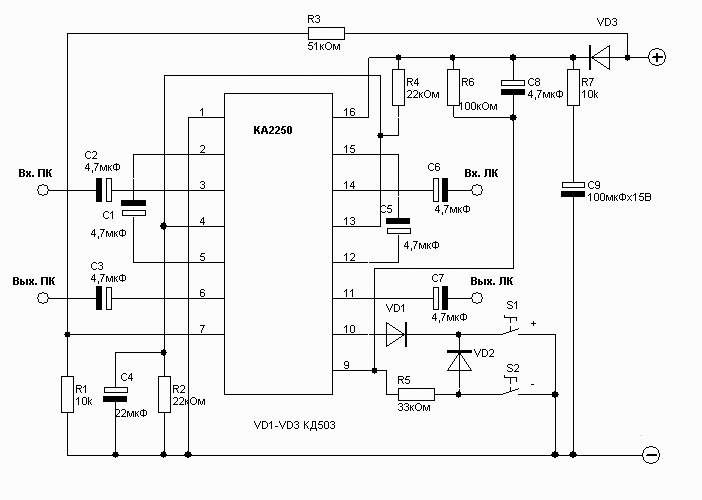The control range, dB 0...66
The adjustment step, 2 dB
The working frequency band, Hz 20 20000...
Harmonic distortion, % 0,005
The voltage, V 3 16...
Shemka like this:

No, no, no need to be frightened - I said - Koreans. They seem to have their own, specific idea about the convenience of the location of the pins and the topology of the circuit. Anyway - the main thing is not too many wall elements, so the chance to get confused still decreases. Actually, to describe there is a signal on the appropriate conclusions, all regulated by two buttons S1 and S2.
As our brothers in mind not provided in the chip non-volatile memory, one would conclude that the volume will need each time to re-set each time you turn the scheme. But no - they got out of this situation in his own way, in Korean. At power-charging the capacitor C9. Once power is lost and the pin 7 of the chip leaves the level of the log. 1, the chip immediately closes all of its inputs and outputs and switches to the mode of consumption of nanotool. Thus, she takes them of course from the capacitor C9. I'll be honest - how long this system will be able to keep it all in working condition, I don't know. Maybe it's just protection against short interruptions in power supply.
A table with a list of items:
The symbol on the diagram
The value
C1
a 4.7 µf
C2
a 4.7 µf
C3
a 4.7 µf
C5
a 4.7 µf
C6
a 4.7 µf
C7
a 4.7 µf
C4
MF
C8
a 4.7 µf
C9
Thu
R1
10k
R2
22kohm
R4
22kohm
R5
Am
R6
100k
R3
Am
R7
10k
S1
Any push-button momentary
S2
Any push-button momentary
VD1
CD
VD2
CD
VD3
KD 503
Chip
CA






